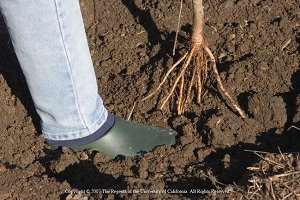By Brent McGhie
There are several advantages to planting bare-root trees: they are usually less expensive, easier for gardeners to transport, and they will grow their roots entirely into native soil (rather than having to transition from potting mix into dissimilar native soil). Also, the ideal time to plant bare-root trees is in the winter, when you have a break from the demands of other garden chores.

Bare root trees are usually available from December through February or March, but before purchasing a tree it's a good idea to select an appropriate planting site and properly prepare it. Choose a site with plenty of sun. Fruit trees need at least 6 hours of sunlight per day; if a tree does not receive enough light, it will grow more slowly and set less fruit (plus, fruit that does set may be smaller and less sweet). Fruit trees also thrive in deep, well-drained soil. If soil is compacted, an area several feet wide around the planting site should be cultivated deeply to loosen the soil for root growth. Avoid adding fertilizer or soil amendments directly to the planting hole; instead, a well-decomposed compost can be worked into the planting site before digging the hole. Finally, if hardpan is present within one and one-half to two feet below the soil surface, it must be penetrated to allow proper drainage and root growth.
Once the planting site has been prepared, it's time to select the tree. Trees with a trunk diameter between one-half and five-eighths of an inch usually become established faster than larger or smaller stock. If the root mass is visible, be sure it is well balanced, not “one-sided.” Remove any dead or damaged roots before planting. It is best to plant bare-root trees immediately after bringing them home, but if this is not possible, the roots should be covered with sawdust or compost and kept moist until planting.
To prevent the tree from settling too low in the ground, dig the planting hole no deeper than the tree's roots. To encourage root growth, the hole should be about twice as wide as the spread of the roots. If the soil contains a large amount of clay, the sides of the hole should be scored to aid outward root growth. Build a cone of soil in the center of the hole and spread the roots over the cone, with the bud union (where the tree was grafted onto the root stock) facing south west. This prevents sun-scald of the flat side of the trunk just above the bud union. Next, back-fill the hole with the same soil that was taken from it until the hole is half filled and gently firm the soil to eliminate large air pockets. Double check the planting depth, making sure the bud union is four to six inches above the soil surface. Finish filling the hole with the native soil and gently firm it once again. When properly planted, the tree's uppermost roots should be just slightly below the soil surface and the soil should slope gently away from the trunk, preventing water from accumulating there.
Thoroughly water the newly-planted tree to settle the soil around the roots. Unless the tree has been planted in wet, heavy clay soil, a basin should be built around the tree. (In clay soils, keeping the soil too wet can eliminate air spaces in the soil, “suffocating” the roots). The basin should be donut-shaped, with the tree sitting in an island of soil in the middle of the basin. Again, to discourage rot, make sure water drains away from the tree. The basin should be slightly wider than the planting hole, ensuring that the entire root area receives water. After growth has begun in spring, water the new tree once or twice per week, adjusting the schedule as needed for cool rainy periods or early hot spells.
Clear an area about 3 feet wide around the tree, eliminating weeds and grasses to keep them from competing with the tree for water and nutrients. To prevent future weed growth and conserve moisture, a layer of mulch 3 to 6 inches thick can be placed around the tree. However, to avoid crown rot, keep the mulch several inches away from the tree trunk. As a final step, remove the top of the tree by pruning back to a single trunk approximately 24 inches tall and paint the bark of the entire tree trunk with white interior latex paint diluted with water (two parts water to one part paint) as a whitewash to reflect excess heat. This prevents sunburn and the resulting invasion of wood-boring insects that can stunt or kill the new tree.
Source: ucanr.edu